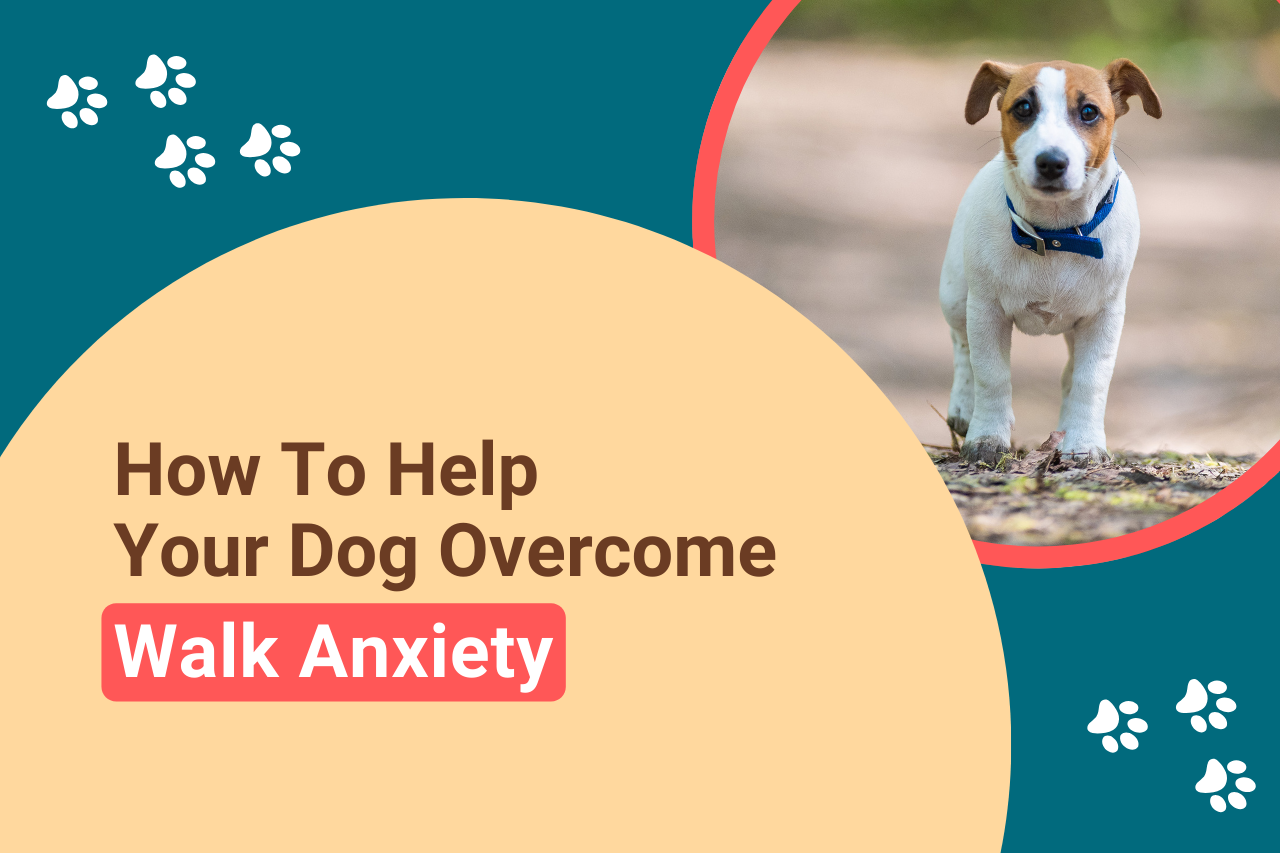
How to Help Your Dog Overcome Walk Anxiety: Effective Strategies for Building Confidence and Enjoyable Walks Together
Walking is more than just a daily routine for dogs; it’s a fundamental aspect of their well-being. These excursions provide essential physical exercise, mental stimulation, and opportunities for socialization. However, what should be an enjoyable experience can become a source of stress for some dogs.
Walk anxiety is a common issue that can manifest in various ways, such as reluctance to leave the house, pulling on the leash, or showing signs of fear. Recognizing and addressing this anxiety is crucial for ensuring that walks remain a positive part of your dog’s day.
In this article, we’ll delve into the causes of walk anxiety and explore practical strategies to help your furry friend overcome this challenge, ensuring that your walks together are enjoyable and stress-free.
Understanding Walk Anxiety in Dogs
Walk anxiety is a condition in which a dog exhibits stress or fear related to going on walks. This can stem from past traumas, negative experiences, or even a lack of socialization.
The symptoms of walk anxiety can vary widely but often include behaviors such as excessive panting, shaking, refusal to move, or attempting to escape the leash. Some dogs may display more subtle signs, like constantly looking around or pulling towards home.
Recognizing these signs early is crucial for effective intervention. Early detection allows for a more proactive approach, preventing the anxiety from becoming deeply ingrained. It’s important to understand that walk anxiety is not just a quirk or a phase; it’s a genuine concern that affects your dog’s quality of life.
By identifying and addressing these symptoms promptly, you can help your dog feel more secure and confident, turning walks into a positive experience. In the following sections, we’ll explore strategies to mitigate walk anxiety, ensuring that your dog can enjoy the many benefits of regular walks without undue stress.
Gradual Exposure and Desensitization
Gradual exposure and desensitization are key steps in helping dogs overcome walk anxiety. This method involves slowly introducing your dog to walking environments in a controlled manner, thereby reducing fear and building positive associations.
By carefully guiding your dog through this process, you can help them develop confidence and enjoy their walks more fully.
Start in a Safe Space
Begin the desensitization process by spending quality time with your dog in a secure and familiar environment. This could be a quiet room or a fenced backyard.
During this time, introduce the leash and harness gently, allowing your dog to sniff and interact with them without any pressure. This initial step is crucial for setting a positive tone for the upcoming training sessions.
Create Positive Associations
To build a positive connection with the walking gear, use treats and praise as rewards. Encourage your dog to approach you while you hold the leash and harness.
Reward them for calm behavior and for showing interest in the gear. This step is essential in creating a positive association, making your dog more receptive to wearing the walking equipment.
Short, Positive Sessions
Start with brief walking sessions in a familiar, low-stress environment, such as your backyard or a quiet area near your home. Keep these sessions short, focusing on making them positive experiences.
End each session with treats and praise to reinforce good behavior. This approach helps your dog associate walking with positive outcomes, gradually reducing their anxiety.
Incremental Exposure to New Environments
Gradually expand your dog’s comfort zone by introducing them to new environments, starting with quieter, less crowded areas.
Each positive experience in these new settings helps build their confidence, making them more comfortable with the idea of exploring further. It’s important to progress at a pace that suits your dog, ensuring that each step is a positive one.
Introduce Varied Stimuli Gradually
Begin to slowly expose your dog to a variety of stimuli they might encounter during walks, such as other people, animals, or vehicles.
Start from a distance where your dog feels comfortable, gradually decreasing the distance as they become more accustomed to each stimulus. This gradual exposure helps prevent your dog from feeling overwhelmed and supports a positive walking experience.
Consistent, Positive Reinforcement
Throughout the entire process, it’s crucial to consistently reward your dog for calm and curious behavior.
Positive reinforcement not only boosts their confidence but also strengthens their trust in you, making each step forward a celebrated achievement. Regular rewards and encouragement help reinforce the idea that walks are enjoyable experiences.
Training Techniques to Build Confidence
Building confidence in dogs with walk anxiety involves a comprehensive approach that includes obedience training, counterconditioning, and focus exercises. These techniques not only help your dog feel more secure during walks but also strengthen the bond and communication between you and your furry friend.
Obedience Commands
Basic obedience commands like “sit,” “stay,” “come,” and “heel” can provide a sense of structure and predictability for your dog.
Consistent training sessions reinforce your role as the leader, giving your dog a sense of security. Use positive reinforcement to reward compliance, and keep training sessions short and enjoyable.
Sniff Spot Training
Incorporate sniff spot training into your routine by designating specific areas during your walk where your dog is allowed to sniff freely. Allowing your dog to explore their environment at their own pace can reduce the pressure they may feel to keep moving and help them feel more relaxed.
Encourage and praise your dog when they engage with these designated sniff spots. This approach not only provides mental stimulation but also gives your dog a sense of control and security, which can be particularly beneficial for those with walk anxiety.
Focus Exercises
Teach your dog to focus on you during walks by using cues like “watch me” or “look.” Start these exercises in a quiet environment, gradually introducing distractions as your dog improves.
Reward them for maintaining eye contact and ignoring potential stressors. This technique can redirect their attention from anxiety triggers and enhance their sense of security.
Consistency and Patience
It’s important to maintain consistency in your training techniques and be patient with your dog’s progress. Each dog is unique, and overcoming walk anxiety may take time. Celebrate small victories and remain supportive and understanding of your dog’s needs.
By incorporating these training techniques, you can help your dog build the confidence they need to enjoy their walks fully. Remember to tailor your approach to your dog’s individual personality and comfort level, and always prioritize their well-being.
Addressing Specific Fears and Triggers
When it comes to walking anxiety, each dog may have their own set of specific fears or triggers. Identifying and addressing these is crucial for helping your dog feel more comfortable and secure during walks.
Identifying Triggers
Start by observing your dog’s behavior closely during walks. Note any patterns or specific situations that seem to cause anxiety, such as encountering other dogs, loud noises, or certain types of vehicles. Keeping a walking diary can be helpful in tracking these triggers.
Counter-Conditioning
Once you’ve identified the triggers, you can begin counter-conditioning, which involves changing your dog’s negative response to a positive one.
For example, if your dog is fearful of other dogs, start by exposing them to a dog at a safe distance while offering treats and praise. Gradually decrease the distance as your dog becomes more comfortable, always ensuring the experience remains positive.
Socialization Exercises
If your dog’s anxiety is triggered by unfamiliar dogs or people, consider controlled socialization exercises. Organize playdates with calm, friendly dogs, or introduce your dog to new people in a controlled, positive environment. Gradual, positive exposure can help reduce fear and anxiety.
Creating a Safe Space
Sometimes, the best strategy is to temporarily avoid the triggers altogether, especially if your dog is extremely fearful. This can provide a temporary reprieve while you work on desensitization and counter-conditioning. For example, if your dog is terrified of busy streets, choose quieter routes for your walks until they become more confident.
Professional Help
If your dog’s fears or triggers are severe, it may be worth consulting a professional dog trainer or behaviorist. They can provide personalized strategies and support to help your dog overcome their anxiety.
Remember, addressing specific fears and triggers takes time and patience. Celebrate your dog’s progress, no matter how small, and maintain a positive and supportive approach throughout the process.
Seeking Professional Help
There are certain situations where seeking help from professionals is necessary to address your dog’s walk anxiety effectively. Understanding when and why to seek this help is crucial for your dog’s well-being.
Veterinarian Consultation
If your dog’s anxiety is sudden, severe, or accompanied by physical symptoms, it’s important to consult a veterinarian. Medical issues such as thyroid problems, pain, or neurological conditions can manifest as anxiety or behavioral changes.
A thorough health check can rule out any underlying medical causes and ensure that your dog receives appropriate treatment.
Behavioral Trainers
If your dog’s walk anxiety persists despite your efforts, or if it escalates to aggression or extreme fear, seeking help from a professional dog trainer or behaviorist is advisable.
These experts can provide tailored strategies and techniques based on your dog’s specific needs. They can also offer guidance on how to implement these strategies effectively and safely.
Specialized Therapies
In some cases, your dog may benefit from specialized therapies such as animal-assisted therapy or cognitive-behavioral therapy. These approaches can be particularly useful for dogs with deep-rooted anxieties or traumas.
Collaborative Approach
Collaborating with professionals ensures a comprehensive approach to addressing your dog’s walk anxiety. It combines medical, behavioral, and therapeutic strategies, providing a well-rounded solution that addresses both the symptoms and the root causes of the anxiety.
Remember, seeking professional help is a sign of responsible pet ownership. It demonstrates your commitment to your dog’s health and happiness, ensuring they receive the best possible care.
Conclusion
In conclusion, addressing walk anxiety in dogs is not just about improving their walking experience; it’s about enhancing their overall quality of life. Recognizing the signs of anxiety and implementing strategies such as gradual exposure, confidence-building training, and addressing specific fears can make a significant difference.
It’s important to approach this process with patience and consistency, celebrating each step of progress. Remember, the goal is to create a positive and enjoyable walking experience for both you and your dog. By investing time and effort into overcoming walk anxiety, you’re not only strengthening your bond with your furry companion but also ensuring they lead a happier, more fulfilled life.






